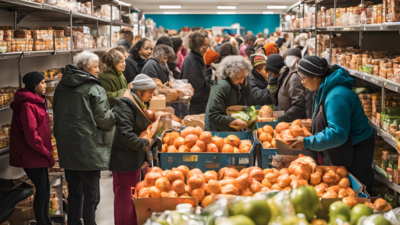
Food banks in Toronto, Canadaare experiencing a surge in demand, with visits exceeding the city’s entire population, according to a new report. Over 10% of Toronto residents rely on food banks, marking a 36% increase from last year, the report said.
Record-breaking visits to Toronto food banks
The Daily Bread Food Bank and North York Harvest Food Bank released their annual “Who’s Hungry” report, revealing nearly 3.5 million food bank visits in the past year. This represents an increase of one million visits compared to the previous year.
“From April 1, 2023, to March 31, 2024, Toronto food banks served a record-breaking 3.49 million client visits—almost 1 million more than last year. This figure exceeds the City of Toronto’s entire population,” the report said.
Toronto’s population is nearly 2.8 million, based on recent census data.
“It is unfathomable that the number of client visits to food banks is now higher than the City of Toronto’s entire population,” said Neil Hetherington, CEO of the Daily Bread Food Bank, as quoted by the Toronto Sun.
The report revealed that more than 1 in 10 Torontonians now rely on food banks, noting that this could include anyone—neighbors, friends, or colleagues. “More than 1 in 10 Torontonians now rely on food banks. This could be you, your neighbors, friends, colleagues, or the people sitting next to you in the subway car,” the report said.
First-time food bank users increase
The report also noted a rise in the number of individuals who had never previously considered using food banks and are now accessing emergency services for the first time. Despite food bank clients reporting higher employment rates and wages, the rising costs of living are making it difficult to keep up.
“And more than ever, we are seeing individuals who had never considered using food banks walking through our doors and accessing our emergency services for the very first time. Even with food bank clients reporting higher employment rates and wages, the rising costs of living are making it impossible to keep up,” the report said.
“With no way to escape poverty, too many of our neighbors are struggling,” it adds.
Growing food insecurity
Statistics Canada reports that 24.9% of Toronto households experience food insecurity, meaning one in four struggle to access adequate food.
The report reveals that almost a third (29%) of these individuals went without food for a full day. Furthermore, 50% skipped meals to afford other necessities.
Poverty contributing to worsening food security
The report stresses a concerning trend of increasing poverty in Canada, impacting food security. After declining between 2015 and 2020, poverty rates have risen since 2021, reaching 9.9% nationally in 2022. Toronto presents a starker picture, with 12.6% of its population living in poverty in 2022—a 34% increase from the previous year, according to the report.
Surge in food bank use among newcomers
The report from Food Banks Canada also revealed that more newcomers to Canada are relying on food banks than ever before. The report notes that 32% of food bank clients have been in Canada for 10 years or less, marking a significant increase from the previous year. Most of these individuals arrived within the last two years.
The report attributes this surge in food bank use to the combined pressures of rising housing costs and food inflation. Alarmingly, nearly 30% of Canadian food banks report having to turn away clients due to a lack of food.
Financial strain on food bank clients
The report stressed the financial strain on food bank users. After covering rent and utilities, these individuals are left with a median of $7.78 per day for food and necessities.
The report notes the average monthly income for a food bank client is $1,265, while the official poverty line for a single person in Toronto is $2,397 per month.
Housing costs represent a significant burden, with 73% of clients allocating half their income toward rent, and 20% dedicating their entire income to housing.
‘Damage is done’
“This unthinkable rate of growth is not something food banks, nor people in Canada, can sustain. The damage is done, and people need immediate supports to help them recover. Everyone must come to the table to solve this problem. We cannot do it alone and need help to drive change,” said Kirstin Beardsleychief executive officer of Food Banks Canada.
Key factors behind the crisis
The report pointed to “decades of underinvestment in public services, infrastructure, and social housing” as key factors contributing to the current cost-of-living crisis.
“Every food bank visit is a policy failure. Who’s Hungry 2024 is a call to action from real individuals trapped in poverty. Together, we are calling on all levels of government to create real long-term solutions to end poverty and food insecurity. Stronger policies around affordable housing, decent wages, newcomer supports, and higher social assistance rates will help ensure that every Torontonian is able to live a life of dignity and realize their right to food,” the report said.
Mississauga declares food insecurity an emergency
The Mississauga City Council recently declared food insecurity an emergency. The decision, made in a recent council meeting, emphasized the severity and persistence of food insecurity in the city.
A press release from the council stressed that this issue is not temporary, saying, “Food insecurity has gone beyond crisis levels and is not a temporary issue.” The council believes the problem has affected too many residents for too long.
Statistics from Food Banks Mississauga paint a stark picture: the organization now serves 1 in 13 Mississauga residents, a significant increase from 1 in 37 in 2019. This past year alone, food banks distributed over 9 million pounds of food, a 55% increase from the previous year. Alarmingly, one-third of those relying on food banks are children.
In response to the escalating situation, the Mississauga City Council is calling for both the federal and provincial governments to join them in declaring food insecurity an emergency.



















